威海市城市风貌保护条例【2020年修订版】
(2016年7月21日威海市第十六届人民代表大会常务委员会第二十九次会议通过 2016年9月23日山东省第十二届人民代表大会常务委员会第二十三次会议批准 根据2019年12月27日威海市第十七届人民代表大会常务委员会第二十一次会议通过并经2020年1月15日山东省第十三届人民代表大会常务委员会第十六次会议批准的《威海市人民代表大会常务委员会关于修改<威海市城市风貌保护条例>等五件地方性法规的决定》修正)
目 录
第一章 总 则
第二章 保护内容
第三章 保护规划
第四章 保护措施
第五章 法律责任
第一章 总 则
第一条 为了加强城市风貌保护,根据有关法律、法规的规定,结合本市实际,制定本条例。
第二条 本市行政区域内城市风貌的保护,适用本条例。
法律、法规对城市风貌保护另有规定的,依照其规定。
第三条 本条例所称城市风貌保护,是指对影响城市风貌特色的自然要素、人文要素和空间控制要素进行综合性的管理与控制,达到保护城市的空间格局、历史风貌、地域特征和文化特色等目的的行为。
第四条 城市风貌保护应当遵循科学规划、严格保护、合理利用、永续发展的原则,正确处理经济社会发展与自然生态保护、历史文化传承的关系。
第五条 市人民政府应当加强对城市风貌保护工作的领导,监督指导有关部门依法履行相关职责,建立健全城市风貌保护工作协调机制,协调解决有关重大问题。区(县级市)人民政府具体负责各自辖区内城市风貌的保护工作。
市、区(县级市)人民政府应当将城市风貌保护工作纳入国民经济和社会发展规划以及年度计划,所需经费列入本级财政预算。
第六条 市住房城乡建设部门是市城市风貌保护行政主管部门。各区(县级市)城乡建设部门是各区(县级市)城市风貌保护行政主管部门。
自然资源、城乡规划、生态环境、城市管理、水务、海洋、文化和旅游、林业等部门应当按照各自职责,依法开展城市风貌保护相关工作。
第七条 建立城市风貌保护专家咨询制度,城市风貌保护相关事项应当征求专家的意见。具体工作规则由市人民政府制定。
第八条 建立城市风貌保护公众参与制度,城市风貌保护相关事项应当广泛听取公众意见。
鼓励公民、法人或者其他组织以捐赠、资助、提供技术服务或者提出意见、建议等方式,参与本市城市风貌保护工作。
第九条 市、县级市人民政府应当定期组织有关部门和专家对城市风貌保护状况进行评估,并向本级人民代表大会常务委员会报告评估结果。
第十条 任何单位和个人都有依法保护城市风貌的义务,有权对破坏城市风貌的行为予以劝阻、制止和举报。
市、区(县级市)人民政府及其有关部门应当开展城市风貌保护宣传和教育工作,提高公众的城市风貌保护意识。
第二章 保护内容
第十一条 城市风貌保护的内容包括:
(一)海岸、海岛、海湾、海滩、礁石、岬角、潟湖、湿地以及山体、森林、古树名木、植被、河流、湖泊、温泉等要素构成的自然风貌;
(二)各历史时期具有文化传承价值的城区、街区、村落和建筑物、构筑物、基础设施、名胜古迹、生产遗迹等人文风貌;
(三)其他具有保护价值的城市风貌保护项目。
第十二条 建立城市风貌保护名录,根据本条例第十一条所列内容,确定城市风貌保护项目。
经批准公布的自然保护区、风景名胜区、森林公园、湿地公园、地质公园、水源保护区、历史文化名城、历史文化街区、历史建筑、历史文化名村、传统村落和文物保护单位等直接纳入城市风貌保护名录。
第十三条 城市风貌保护名录的编制和调整,由市城市风貌保护行政主管部门会同有关部门、区(县级市)人民政府研究提出,经专家评审、社会公示后,报市人民政府批准后公布,并报市人民代表大会常务委员会备案。
第十四条 任何单位和个人都有权提出将具有保护价值的项目列入城市风貌保护名录的建议。
任何单位和个人发现尚未列入城市风貌保护名录但是可能具有保护价值的项目,面临被拆除、损毁、破坏等风险,可以向各级城市风貌保护行政主管部门报告,城市风貌保护行政主管部门应当自收到报告后三日内回复报告人。
第十五条 城市风貌保护行政主管部门对尚未列入城市风貌保护名录但是可能具有保护价值的项目,面临被拆除、损毁、破坏等风险的,应当立即制止,并对项目采取应急性保护措施。相关单位或者个人收到制止通知后应当立即停止相关行为。
城市风貌保护行政主管部门应当自制止通知发出后七日内作出处理决定。
第十六条 市城市风貌保护行政主管部门应当根据城市风貌保护名录建立城市风貌保护档案。
第十七条 市城市风貌保护行政主管部门应当建立城市风貌保护数据库和管理信息系统,采集城市风貌保护相关信息,对城市风貌保护项目进行动态监测和管理。
第三章 保护规划
第十八条 城市风貌保护规划是城市风貌保护的基本依据,各种开发和建设活动应当符合城市风貌保护规划的要求。
城市风貌保护规划涉及海域使用的,应当符合海洋功能区划。
第十九条 市城市风貌保护行政主管部门应当会同市城乡规划等有关部门和区人民政府,组织编制中心城区城市风貌保护规划,确定城市风貌分区控制体系和控制措施。
县级市城市风貌保护行政主管部门应当根据本地实际情况,编制本地城市风貌保护规划。
编制城市风貌保护规划,应当根据国土空间规划和不同区域的发展条件、用地性质以及分区关系,科学规划城市布局,保持城市特有的地域环境、文化特色和建筑风格,塑造城市整体形象,并与详细规划相衔接。
第二十条 编制城市风貌保护规划,应当进行科学论证、广泛征求意见,经市、县级市城乡规划委员会研究同意,报市、县级市人民代表大会常务委员会审议通过后,向社会公布。
第二十一条 城乡规划主管部门应当组织编制城市设计导则,对规划区域的景观体系、街道、开敞空间以及建筑形体、色彩、体量、高度等,确定控制要求。
城市设计导则的编制和调整,应当经专家评审、社会公示后,报市、县级市人民政府批准后公布。
第二十二条 城乡规划主管部门应当会同相关部门依据国土空间规划,组织编制详细规划,明确保护范围、建设控制范围、风貌保护要素、保护实施方案等。
详细规划经市、县级市人民政府批准后,报本级人民代表大会常务委员会备案。
第二十三条 建立城市绿线、蓝线、紫线管理制度。
城市规划区内的绿地、沿海防护林、道路防护林、河流防护林、景观生态林、绿道、山体等区域应当划定城市绿线。
城市规划区内的河流、湖泊、水库、湿地等区域应当划定城市蓝线。
历史文化名城、历史文化街区、历史建筑等区域应当划定城市紫线。
划定的城市绿线、蓝线、紫线是对应区域的城市风貌保护范围,城乡规划主管部门应当会同相关部门编制详细规划,规定保护要求和控制指标。
第二十四条 城乡规划主管部门应当将城市绿线、蓝线、紫线外侧的一定区域划为建设控制地带,明确建筑物退线距离以及其他建设控制要求。
第四章 保护措施
第二十五条 在本市行政区域范围内从事开发建设、生产经营等活动,应当符合城市风貌保护的相关要求。
在城市风貌保护项目的保护范围内,不符合城市风貌保护规划要求的既有建筑物、构筑物以及其他设施,应当在更新、改造时进行整修、迁建或者拆除。
第二十六条 市人民政府应当划定基本生态控制线,作为管控城市开发建设的边界。
除因公共利益需要确需占用基本生态控制线区域外,禁止在基本生态控制线范围内从事项目开发以及其他可能损害、破坏生态环境的活动。
本条所称基本生态控制线,是指为保障城市基本生态安全,维护生态系统的科学性、完整性和连续性,防止城市建设无序蔓延,在尊重城市自然生态系统和合理环境承载力的前提下,划定的生态保护范围界线。
第二十七条 市人民政府应当结合海岸带自然环境、资源现状和开发情况,划定海岸带范围及自然岸线保护范围。
第二十八条 严格保护海滨生态风貌。在海岸带范围内:
(一)禁止破坏海湾、沙滩、礁石、潟湖、湿地、河口等特殊地形地貌以及自然景观;
(二)禁止开挖山体、采石、采砂;
(三)禁止露天采矿。
在自然岸线保护范围内,禁止任何破坏自然岸线的地形地貌的行为。
第二十九条 威海中心城区,西起烟威分界线东至茅子草口区域内,禁止下列活动:
(一)在砂质岸线区域内进行建设活动;
(二)从事新建港口、码头等活动。
第三十条 严格保护沿海防护林。禁止在沿海国家特殊保护林带内从事开发建设、生产经营活动。
第三十一条 城乡规划主管部门应当根据相关法律法规和城市风貌保护规划,划定重点地段建筑高度控制线,确定建筑后退距离,保持视线通廊畅通,塑造良好的城市天际轮廓线,形成具有威海特色的城市空间格局。
第三十二条 在海岸带范围内,严格控制新建建筑的高度、密度、体量和容积率。海岸带及其邻近区域内的建设项目,应当进行视线景观分析,不得对海滨形成封闭式遮挡。
在海岸带新建建筑应当按照自大陆岸线向陆地一侧基岩海岸后退不小于八十米、砂质海岸不小于二百米、堤岸等人工岸线不小于二十米的距离的原则确定。
第三十三条 滨河、滨湖等滨水区域一线建筑高度应当与水系环境相协调,建筑后退河岸线、湖岸线不得少于二十米。
第三十四条 城乡规划主管部门应当划定重要观景点与主要山体之间的眺望视域,严格控制眺望视域内建筑的高度、体量。临山地块高层建筑通透率不得低于百分之三十五。
第三十五条 市城乡规划主管部门应当按照不超过背景山体海拔高度三分之二的原则确定山体周边建筑高度控制线。山体周边区域新建、改建、扩建建筑的屋脊线海拔高度不得突破高度控制线。
第三十六条 威海中心城区下列区域内新建、改建、扩建建筑高度应当符合以下要求:
(一)环翠楼、高角山、塔山构成的三角区域内不得超过六十米;
(二)环翠楼、东山宾馆、金线顶构成的三角区域内不得超过五十米;
(三)里口山城市山地公园区域内不得超过二十四米。
第三十七条 城市绿线范围内的土地不得改变其用地性质,不得违反法律法规、强制性标准以及批准的规划进行开发建设。
第三十八条 在城市蓝线范围内,禁止从事下列行为:
(一)建设建筑物、构筑物,但是建设水工程和环境保护设施除外;
(二)开垦、填埋湿地;
(三)擅自填埋、占用水域;
(四)爆破、采石、采砂、取土;
(五)其他破坏城市水系、湿地的行为。
第三十九条 历史文化名城的核心保护区、历史文化街区应当严格控制建设活动,保持特有的风貌和建筑特色。经依法批准的建设项目,其高度、体量、形态、色彩应当与整体风貌相协调。
禁止在历史文化街区的核心保护区内新建、扩建建筑物。但是,新建、扩建必要的公益性基础设施和服务设施除外。
第四十条 历史文化名城的核心保护区、历史文化街区内,新建建筑高度不得高于其周边的被认定为文物保护单位的建筑、历史建筑等保护主体。
历史文化街区建设控制地带内新建建筑高度不得超过十二米。
第四十一条 尚未公布为文物保护单位的北洋海军遗留建筑和英租威海卫时期遗存的英式建筑及其他有价值的历史建筑应当实施原址保护,任何单位或者个人不得改建、迁移或者拆除。
第四十二条 各区(县级市)人民政府应当对列入城市风貌保护名录的海草房、传统村落等乡土建筑制定保护措施,防止有关建筑遭到破坏或者拆除。
第四十三条 具有传统文化特色的古民居、古墓葬、家庙祠堂、大礼堂、引水渡槽等乡土文化遗产,以及具有历史、科学、艺术价值的建筑物(群),列入城市风貌保护名录的,有关行政主管部门可以与管理单位或者所有权人签订保护协议,明确保护责任。
第四十四条 城市风貌保护项目的保护范围内确需建设的,城乡规划部门应当征求城市风貌保护行政主管部门的意见,由城市风貌保护行政主管部门出具建设条件意见书,提出风貌保护要求。
第四十五条 所有权人、管理人或者使用人应当按照要求做好城市风貌保护项目及其相关设施的保养、维护、修复和修缮工作。
市、区(县级市)人民政府对保养、维护、修复、修缮城市风貌保护项目的活动可以给予资金补助。
第四十六条 城市风貌保护项目的修复、修缮,应当保持原有风貌特色,不得改变其原有格局、体量、风格、形态以及相应的地形地貌等。
第四十七条 鼓励将城市风貌保护项目对社会公众开放以及利用保护项目发展文化创意、文化研究和旅游休闲产业,或者以其他形式进行保护和利用。
第四十八条 使用列入城市风貌保护名录的建筑物(群),应当遵循保护性利用和不改变原状的原则,不得破坏建筑物(群)外观和内部主体结构,并严格遵守消防、安全管理等有关法律法规。
第四十九条 禁止利用国有文物保护单位、历史建筑、公园等公共资源以出租、出借、合作等形式设立高档餐饮、休闲、健身、美容、娱乐、住宿、接待等私人会所。
第五章 法律责任
第五十条 市城市风貌保护行政主管部门以及有关部门应当加强对城市风貌保护情况的监督检查,依法查处破坏城市风貌的行为。
第五十一条 对违反本条例规定的行为,法律、法规对其法律责任已有规定的,依照相关规定执行。
第五十二条 各区(县级市)人民政府或者有关部门及其工作人员有下列情形之一的,由本级人民政府、上级人民政府及其有关部门或者监察机关依据职权批评教育、责令改正,并视情节可以对直接负责的主管人员和其他直接责任人员依法给予处分:
(一)违反本条例第十三条、第十九条和第二十二条有关规定,未按照要求组织编制或者擅自修改有关规划、城市风貌保护名录的;
(二)违反本条例第十四条、第十五条有关规定,具有保护价值的项目面临被拆除、损毁、破坏等风险,接到有关单位或者个人的报告后未在法定期限内作出处理的;
(三)违反本条例第四十二条有关规定,对列入城市风貌保护名录的海草房、传统村落等乡土建筑未制定保护措施予以保护的;
(四)违反本条例有关规定,擅自批准影响城市风貌的建设工程的;
(五)其他未依法履行职责,造成城市风貌保护项目灭失、损毁或者破坏的。
第五十三条 违反本条例第二十八条第一款第一项有关规定,在海岸带范围内破坏海湾、沙滩、潟湖、湿地、河口等特殊地形地貌以及自然景观的,由自然资源等部门按照各自职责,责令停止违法行为,恢复原状或者采取其他补救措施,处每平方米五千元罚款;有违法所得的,没收违法所得。
第五十四条 违反本条例第二十八条第一款第一项、第二项和第三项有关规定,在海岸带范围内破坏礁石和开挖山体、采石、采砂以及露天采矿的,由自然资源等部门按照各自职责,责令停止违法行为,恢复原状或者采取其他补救措施,没收违法所得,并处每立方米三千元罚款。
违反本条例第二十八条第二款规定,在自然岸线保护范围内开挖山体、采石、采砂以及露天采矿的,由自然资源等部门按照各自职责,责令停止违法行为,恢复原状或者采取其他补救措施,没收违法所得,并处每立方米五千元罚款。
第五十五条 违反本条例规定,擅自在第二十九条规定的区域内从事新建港口、码头等活动的,由海洋行政主管部门责令限期改正、恢复原状,没收违法所得,并处非法占用海域期间内该海域面积应缴纳的海域使用金二十倍的罚款。
第五十六条 违反下列规定,未取得建设工程规划许可证或者未按照建设工程规划许可证的规定进行建设的,由城乡规划主管部门责令停止建设;尚可采取改正措施消除影响的,限期改正,处建设工程造价百分之五的罚款;无法采取改正措施消除影响的,限期拆除,不能拆除的,没收实物或者违法收入,可以并处建设工程造价百分之十的罚款。停止建设或者限期拆除决定下达后,当事人不停止建设或者逾期不拆除的,城乡规划主管部门可以依法采取查封施工现场、强制拆除等措施。
(一)擅自在本条例第二十九条第一项规定的区域内从事建设活动的;
(二)威海中心城区重要区域内新建、改建、扩建建筑高度违反本条例第三十六条有关规定的;
(三)在历史文化街区的核心保护区内新建、扩建建筑物的。
第五十七条 违反本条例第三十条规定,擅自在沿海国家特殊保护林带内从事开发建设活动的,由林业部门责令停止违法行为,补种毁坏株数三倍的树木,可以处毁坏林木价值五倍的罚款;拒不补种树木或者补种不符合国家有关规定的,由林业部门代为补种,所需费用由违法者支付。
第五十八条 违反本条例第三十八条第二项、第四项规定,开垦、填埋湿地或者在湿地内采石、采砂、取土的,由林业部门责令停止违法行为,恢复原状或者采取其他补救措施,没收违法所得,并处下列罚款:
(一)开垦、填埋湿地的,处每平方米二千元罚款;
(二)在湿地内采石、采砂、取土的,处每立方米三千元罚款。
第五十九条 违反本条例第三十八条第三项规定,擅自在城市蓝线范围内填埋、占用水域的,由水务行政部门责令停止违法行为,恢复原状或者采取其他补救措施,并处五万元罚款。
第六十条 违反本条例规定,有下列行为之一的,由文物行政主管部门责令停止违法行为、恢复原状或者采取其他补救措施,并处以下罚款:
(一)擅自改建、迁移或者拆除尚未公布为文物保护单位的北洋海军遗留建筑或者英租威海卫时期遗存的英式建筑以及其他有价值的历史建筑的,对管理单位或者所有权人处十万元以上二十万元以下的罚款;
(二)破坏、拆除列入城市风貌保护名录的海草房、传统村落建筑的,对个人处五万元以上十万元以下的罚款,对单位处十万元以上三十万元以下的罚款。
第六十一条 违反本条例第四十六条规定,修复、修缮改变城市风貌保护项目格局、体量、风格、形态及地形地貌的,由城市风貌保护行政主管部门责令停止违法行为、恢复原状或者采取其他补救措施,有违法所得的,没收违法所得,并处五万元以上十万元以下的罚款。
第六十二条 违反本条例规定,造成损害的,依法承担民事责任;构成犯罪的,依法追究刑事责任。
第六章 附 则
第六十三条 本条例自2016年11月1日起施行。
威海市自然资源和规划局关于印发《威海市山体保护条例》等行政处罚裁量基准的通知
威自然资发〔2022〕75号
各区市自然资源局,各区规划分局,机关各科室、直属事业单位:
为规范《威海市山体保护条例》等设定的行政处罚事项裁量基准的制定和使用,促进严格规范公正文明执法,切实保障当事人的合法权益,市自然资源和规划局研究制定了《威海山体保护条例》等行政处罚裁量基准清单,现印发给你们,请认真遵照执行。
本通知自2023年1月15日起施行,有效期至2028年1月14日。
威海市自然资源和规划局
2022年12月15日
(此件公开发布)
(此件公开发布)
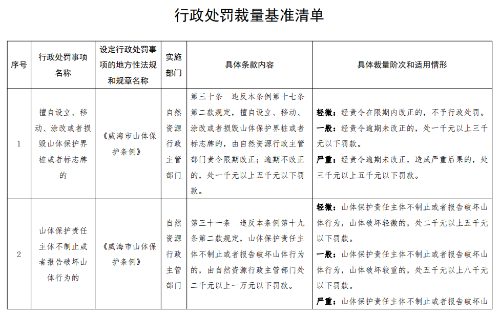
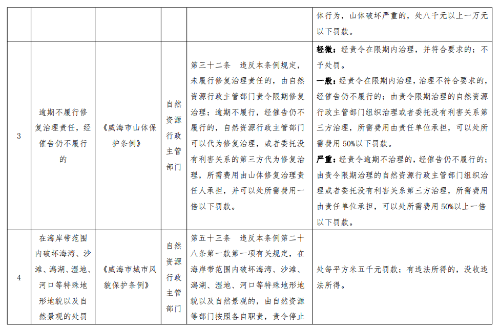
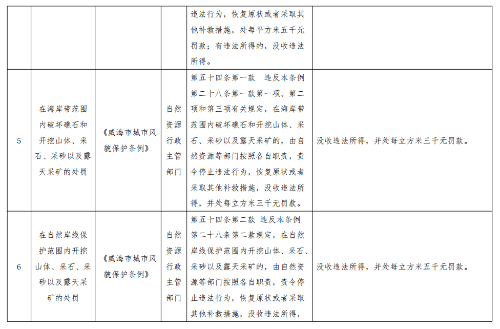
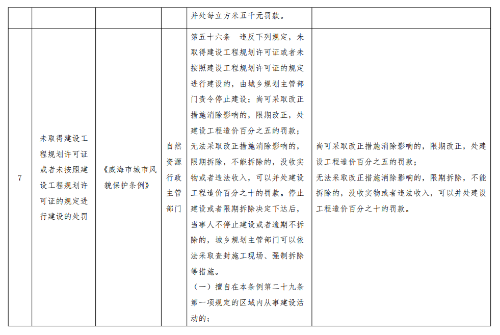
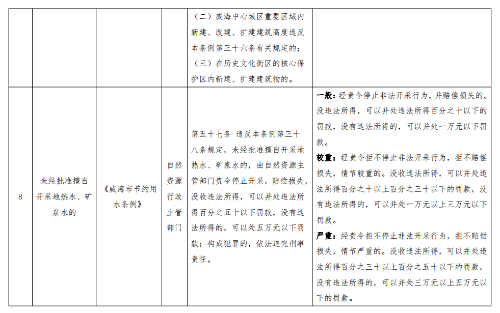
http://www.weihai.gov.cn/art/2022/12/15/art_103264_21906.html
《威海市自然资源和规划局关于印发<威海市山体保护条例>等行政处罚裁量基准的通知》政策解读
时间: 2022-12-16
一、政策背景
行政处罚是行政执法部门行使的重要行政执法权,处罚裁量是否合理、适当,直接影响行政相对人的权益。建立行政处罚裁量基准制度,能够规范执法部门自由裁量权,切实保障地方性法规的正确实施,提高行政执法质量和公信力。为规范《威海市山体保护条例》《威海市城市风貌保护条例》《威海市节约用水条例》等地方性法规设定的行政处罚事项裁量基准的制定和使用,促进严格规范公正文明执法,切实保障当事人的合法权益,市自然资源和规划局研究制定《威海山体保护条例》等行政处罚裁量基准清单(以下简称“裁量基准”)。
二、基本原则
行政处罚自由裁量权是在具体执法办案活动中客观存在的。裁量基准的制定考虑行政处罚的公平公正合理,同时兼顾行政执法的实际特点,在充分调研并听取各方意见的基础上,遵循以下原则:
(一)合法性原则。为了切实履行法定职责,《裁量基准》严格根据《中华人民共和国行政处罚法》《山东省规范行政处罚裁量权办法》等有关规定,在法规规定的处罚种类和幅度范围内划分不同阶次,未超越法定的自由裁量幅度和范围。
(二)合理性原则。实施裁量基准制度,是为了规范而非剥夺裁量权,《裁量基准》结合违法行为的事实、性质等对违法情节予以量化,对应相应违法程度,并统一罚款的量罚幅度标准。
(三)公平公正原则。建立裁量基准制度,执法人员可以依据情节对应的标准进行处罚,从源头上避免执法办案的随意性。当事人也可以按照违法情节对号入座,对执法人员自由裁量权的行使进行监督,确保行政处罚行为的公平、公正、合理。
三、主要内容
《裁量基准》对《威海市山体保护条例》中“擅自设立、移动、涂改或者损毁山体保护界桩或者标志牌的”“山体保护责任主体不制止或者报告破坏山体行为的”“逾期不履行修复治理责任,经催告仍不履行的”,《威海市城市风貌保护条例》“在海岸带范围内破坏海湾、沙滩、潟湖、湿地、河口等特殊地形地貌以及自然景观的处罚”“在海岸带范围内破坏礁石和开挖山体、采石、采砂以及露天采矿的处罚”“在自然岸线保护范围内开挖山体、采石、采砂以及露天采矿的处罚”“未取得建设工程规划许可证或者未按照建设工程规划许可证的规定进行建设的处罚”及《威海市节约用水条例》“未经批准擅自开采地热水、矿泉水的”等8项违法行为具体裁量阶次和适用情形予以规定,保证行政处罚裁量权的正确行使,维护社会公平正义,保护公民、法人和其他组织的合法权益。
四、政策解读人
市自然资源和规划局法规科 陈瑜,0631—5173035。
Regulations of Weihai Municipality on City Scape Protection
(Adopted at the 29th session of the Standing Committee of the 16th People’s Congress of Weihai Municipality on July 21, 2016, approved at the 23rd session of the Standing Committee of the 12th People’s Congress of Shandong Province on September 23, 2016, and amended in accordance with the Decision of the Standing Committee of the People’s Congress of Weihai Municipality on Amending the Regulations of Weihai Municipality on City Scape Protection and Other Four Local Regulations adopted at the 21st session of the Standing Committee of the 17th People’s Congress of Weihai Municipality on December 27, 2019 and approved at the 16th session of the Standing Committee of the 13th People’s Congress of Shandong Province on January 15, 2020.)
Contents
Chapter I General Provisions
Chapter II Protection Contents
Chapter III Protection Planning
Chapter IV Protection Measures
Chapter V Legal Liabilities
Chapter I General Provisions
Article 1 These Regulations are enacted in accordance with the provisions of relevant laws and regulations and in light of the actual situations of this Municipality, for the purpose of strengthening city scape protection.
Article 2 These Regulations shall be applicable to the city scape protection within the administrative region of this Municipality.
Where any law or regulation provides otherwise for city scape protection, such law and regulation shall prevail.
Article 3 For the purposes of these Regulations, city scape protection refers to the comprehensive management and regulation of natural, human and spatial control elements affecting city scape in order to protect the spatial pattern, historical style, regional characteristics and cultural features of the Municipality.
Article 4 City scape protection shall follow the principles of scientific planning, strict protection, appropriate utilization, and sustainable development. The relationship between economic and social development, natural ecological protection, and historical and cultural inheritance shall be handled properly.
Article 5 The municipal people’s government shall strengthen its leadership in the city scape protection, supervise and guide relevant departments to perform their functions and duties according to law, and establish and complete the city scape protection coordination mechanism to coordinate and address major issues. The district (county-level city) people’s governments shall be responsible for the city scape protection within their respective administrative areas.
The municipal and district (county-level city) people’s governments shall incorporate the city scape protection into the national economic and social development plans and annual planning, and include the needed expenses in the financial budget of the governments at the corresponding levels.
Article 6 The municipal housing and urban-rural construction department shall be the administrative department of city scape protection in the Municipality. The district (county-level city) urban and rural construction department shall be the administrative department of city scape protection in the districts (county-level cities).
The administrative departments of natural resources, urban and rural planning, ecological environment, urban management, water-related affairs, maritime, culture and tourism, forestry and otherwise shall, in accordance with their respective functions and duties, carry out relevant work of city scape protection in accordance with laws.
Article 7 The expert consultation system for city scape protection shall be established and opinions of experts concerning relevant issues of city scape protection shall be solicited. The specific working rules shall be formulated by the municipal people’s government.
Article 8 The system for public participation in the city scape protection shall be established and public opinions concerning relevant affairs of city scape protection shall be widely solicited and considered.
Citizens, legal persons and other organizations shall be encouraged to participate in the city scape protection of this Municipality by such means as donation, financial support, provision of technical services, provision of opinions and suggestions, and otherwise.
Article 9 The municipal and county-level city people’s governments shall regularly organize relevant departments and experts to evaluate the condition of city scape protection and report the evaluation results to the standing committee of the people’s congress at the corresponding level.
Article 10 All units and individuals shall be obliged to protect the city scape according to law, and shall be entitled to dissuade, stop and report acts damaging the city scape.
The municipal and district (county-level city) people’s governments and relevant departments thereunder shall carry out promotion and education on city scape protection to raise public awareness of city scape protection.
Chapter II Protection Contents
Article 11 The contents of city scape protection shall include:
(i) coast, islands, bays, beaches, reefs, horns, lagoons, wetlands, and natural scape consisting of such elements as mountains, forests, precious ancient trees, vegetation, rivers, lakes, hot springs, and otherwise;
(ii) cultural scape such as urban areas, streets, villages and buildings, structures, infrastructures, historical sites, and production relics that have cultural heritage values in various historical stages;
(iii) other city scape projects with the value of protection.
Article 12 The city scape protection catalogue shall be established to identify the city scape protection items in accordance with Article 11 of these Regulations.
Natural reserves, scenic spots, forest parks, wetland parks, geological parks, water conservation areas, famous historic and cultural cities and blocks, historic buildings, famous historic and cultural villages, traditional villages, and cultural relics protection units released upon approval shall be directly included in the city scape protection catalogue .
Article 13 The administrative departments of city scape protection shall, in collaboration with the relevant departments and the district (county-level city) people’s governments, study and propose the compilation and adjustment of the city scape protection catalogue, submit to the municipal people’s government for approval upon expert evaluation and public announcement, release to the public upon approval, and submit to the the standing committee of the municipal people’s congress for the recordation.
Article 14 All units and individuals shall have the right to propose to include items with protection value in the city scape protection catalogue.
Any unit or individual may, in case of discovering any item that has not been included in the protection catalogue but may have protection value is subject to the risks of being demolished, damaged or destroyed, report to the administrative department of city scape protection at all levels. The administrative department shall respond to the reporter within 3 days upon receiving the report.
Article 15 Where a project that has not been included in the protection catalogue but may have protection value is subject to the risks of being demolished, damaged or destroyed, the administrative department of city scape protection shall immediately stop such acts of demolition, damage or destruction and take emergency protection measures for the project. The relevant units or individuals shall immediately stop such acts upon receiving the notice of prohibition.
The administrative department of city scape protection shall make a decision within 7 days after the issuance of the prohibition notice.
Article 16 The municipal administrative department of city scape protection shall establish an archive of city scape protection in accordance with the city scape protection catalogue.
Article 17 The municipal administrative department of city scape protection shall establish a city scape protection database and a management information system to collect relevant information of city scape protection and conduct dynamic monitoring and management of city scape protection projects.
Chapter III Protection Planning
Article 18 The city scape protection planning shall be the fundamental basis for the city scape protection. Various development and construction activities shall comply with the protection planning.
Where the city scape protection planning involves the use of sea areas, the marine functional zoning plans shall be complied with.
Article 19 The municipal administrative department of city scape protection shall, in collaboration with the municipal urban-rural planning department, other departments concerned and the district people’s governments, organize the compilation of city scape protection planning for the central urban area, and determine the city scape zoning control system and control measures.
The administrative departments of city scape protection of the county-level cities shall, in light of actual situations, compile the local city scape protection plans.
The compilation of city scape protection planning shall, in accordance with the national spatial planning and development conditions, land use nature and partition relationship of different areas, scientifically plan the layout of the city, maintain the unique regional environment, cultural features and architectural style, shape the integrated city image, and cohere with the specific planning.
Article 20 The compilation of the city scape protection planning shall carry out scientific assessment and extensive collection of public opinions, be studied and approved by the urban-rural planning committees at the municipal or county level, and announced to the public upon being deliberated and adopted by the standing committees of the people’s congress at the municipal or county level.
Article 21 The urban-rural planning department shall organize the compilation of urban design guidelines to determine the requirements for the scape system, streets, open spaces and architectural forms, colors, volumes and heights in the planned areas.
The compilation and adjustment of urban design guidelines shall, upon being reviewed by experts and publicly announced, be submitted to the people’s government at the municipal or county level for approval and promulgated thereafter.
Article 22 The urban-rural planning department shall, in collaboration with relevant departments, organize and compile the detailed planning in accordance with the national territorial spatial planning, and specify the protection scope, the restricted construction area, the elements of scape protection, and the implementation plan for protection.
The detailed planning shall, upon being approved by the municipal and county-level people’s governments, be submitted to the standing committee of the people’s congress at the same level for recordation.
Article 23 The management system of urban green line, blue line and purple line shall be established.
The urban green line shall be demarcated in such areas as green belts, coastal shelter forest, road shelter forest, river shelter forest, scape ecological forest, greenways and mountains within the urban planning area.
The urban blue line shall be demarcated in such areas such rivers, lakes, reservoirs, and wetlands within the urban planning area.
The urban purple line shall be demarcated in such areas as famous historic and cultural cities, streets and historic buildings.
The demarcated urban green line, blue line and purple line shall indicate the city scape protection scope in the corresponding areas and the urban-rural planning department shall, in collaboration with relevant departments, formulate the detailed planning to provide for the protection requirements and control indicators.
Article 24 The urban-rural planning department shall designate certain areas on the outer side of the urban green line, blue line and purple line as restricted construction zones, specify the requirements for distance from buildings to these areas as well as other requirements for construction control.
Chapter IV Protection Measures
Article 25 Activities of development, construction, production and operation within the administrative areas of this Municipality shall comply with the relevant requirements for the city scape protection.
All existing buildings, structures and other facilities that do not meet the requirements of city scape protection planning within the scope of city scape protection projects shall be refurbished, relocated or demolished in renovation and renewal.
Article 26 The municipal people’s government shall delimit the basic ecological control line as the boundary for controlling urban development and construction.
It is prohibited to conduct project development and other activities that may damage or destroy the ecological environment within the scope of the basic ecological control line, unless such occupation of area within the basic ecological control line is for the public interests.
The basic ecological control line as referred to in this article means the ecological protection boundary demarcated on the premise of respecting the natural ecosystem and reasonable environmental carrying capacity of the city and for the purposes of guaranteeing the basic ecological security of the city, maintaining the scientificalness, integrity and continuity of the ecological system and preventing the disorderly spread of urban construction.
Article 27 The municipal people’s government shall delimit the scope of the coastal zone and the protection scope of the natural shoreline in accordance with the natural environment of the coastal zone, the current situation of the resources and its development.
Article 28 The coastal ecological features shall be strictly protected. Within the scope of coastal zone, it is prohibited to:
(i) destroy the special topography and natural scape such as bays, beaches, reefs, lagoons, wetlands and estuaries;
(ii) carry out mountain excavation, quarrying, and sand mining;
(iii) carry out open-pit mining.
It is prohibited to conduct any act of destroying the natural shoreline’s topography within the scope of natural shoreline protection.
Article 29 Within the central urban area of Weihai, from the Yantai-Weihai boundary line in the west to the Maoziokou area in the east, it is prohibited to:
(i) carry out construction activities within the sandy shoreline;
(ii) engage in such activities as establishment of new ports and docks.
Article 30 The coastal shelter forests shall be strictly protected. It is prohibited to engage in the development, construction, production and operation activities within the coastal forest belts under the special protection of the State.
Article 31 The urban-rural planning department shall, in accordance with relevant laws and regulations and the city scape protection planning, delimit the height control lines of buildings in key areas, determine the building’s receding distance, keep the sight-gallery unobstructed, and shape a good city horizon contour line to form an urban spatial pattern with Weihai characteristics.
Article 32 The height, density, volume and floor area ratio of new buildings within the coastal zone shall be strictly controlled. Construction projects within the coastal zone and its adjacent areas shall be analyzed for visual scape and shall not form closed occlusions on the waterfront.
The newly-established buildings in the coastal zone shall be determined based on the principle of not less than 80 meters’ distance from the continental coastline to the bedrock coast on the land side, not less than 200 meters’ distance from the sandy coast, and not less than 20 meters’ distance from such artificial coastline as the embankment.
Article 33 The first-line buildings in waterfront areas such as riverside and lakeside shall be in coordination with the water system environment, and the building’s distance from the riverbank line and lake shoreline shall not be less than 20 meters.
Article 34 The urban-rural planning department shall delimit the viewing area between important scenic spots and major mountains, and strictly control the height and volume of the buildings within the viewing